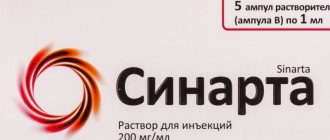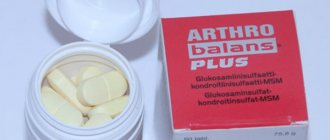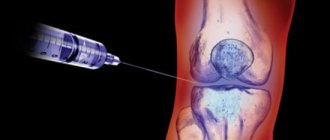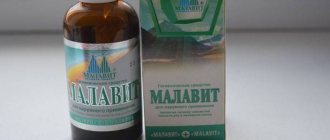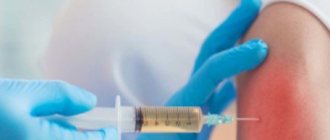Many people are familiar with degenerative inflammatory joint diseases.
Today, pathologies of this nature are common. Unfortunately, it is not always possible to cure diseases of the spine, bones, and joints. The goal of therapy is aimed at stopping deformation and degenerative changes in damaged tissues, restoring nutrition and maintaining a stable condition.
Many patients are prescribed the drug Dona, developed using a special technique. Reviews from experts indicate that the medicine is effective and has a positive effect on joint tissue.
Dona is a medicine that restores damaged cartilage tissue. Moreover, the drug has a minimal list of contraindications and side effects.
Pharmacological properties of the drug Dona
Pharmacodynamics . A drug that affects metabolic processes in cartilage tissue. Glucosamine sulfate is a salt of the natural aminomonosaccharide glucosamine with low molecular weight, carefully purified from macromolecular components. The drug replenishes the endogenous deficiency of glucosamine, stimulates the synthesis of proteoglycans and hyaluronic acid in synovial fluid. Increases the permeability of the joint capsule, restores enzymatic processes in the cells of the synovial membrane and articular cartilage. The anti-inflammatory effect of glucosamine sulfate is due to blocking the formation of superoxide radicals by macrophages and inhibition of lysosomal enzymes, interleukin 1, collagenase, phospholipase A2, which leads to a slowdown in structural damage to articular cartilage, which has been repeatedly proven in long-term clinical studies. The drug promotes the fixation of sulfur in the process of chondroitinsulfuric acid synthesis and normal calcium deposition in bone tissue. Inhibits the development of degenerative processes, reduces the severity of joint pain and restores their function. Sulfates are also involved in the synthesis of glycosaminoglycans and the metabolism of cartilage tissue. The sulfate ester side chains of proteoglycans play an important role in maintaining the elasticity and water retention capacity of the cartilage matrix. A decrease in the severity of clinical symptoms is usually noted 2 weeks after the start of treatment, with clinical improvement continuing for 8 weeks after discontinuation of the drug. The results of clinical studies of continuous therapy with the drug for 3 years indicate a progressive increase in its effectiveness, expressed in regression of disease symptoms and slowdown of structural damage to articular cartilage, confirmed by X-ray. Glucosamine sulfate is well tolerated, with no significant effects on the cardiovascular, respiratory or central nervous system. Lidocaine hydrochloride is a local anesthetic that is used to reduce pain when the drug is administered intramuscularly. Pharmacokinetics . Glucosamine sulfate is quickly and completely absorbed in the small intestine (90%). Easily passes through biological barriers and penetrates tissue, mainly articular cartilage. Bioavailability - 26%. The half-life of the drug is 68 hours.
Use of the drug Dona
Orally, for adults and elderly patients, 1 sachet (1.5 g) 1 time per day for 4–12 weeks or longer (if necessary). Before use, the contents of the sachet are dissolved in 200 ml of water and taken with meals. The course of treatment can be repeated 2-3 times a year with an interval of 2 months, as well as in case of relapse of the disease. The solution is intended for intramuscular administration only! Before use, mix the solvent (solution B) with the drug (solution A) in one syringe. The prepared solution is administered to adults intramuscularly, 3 ml 3 times a week for 4–6 weeks. Injections can be combined with oral administration of the drug.
Contraindications and adverse reactions
Don's drug is not recommended for all patients. Pregnant women and nursing mothers, as well as people with cardiac abnormalities and diseases of the excretory system should avoid using this product. In some cases, the patient may experience adverse reactions. These include the following:
- drowsiness;
- hallucinations;
- dizziness;
- darkening of the eyes;
- tremor;
- dry mouth.
Adverse reactions are extremely rare, but before you start using this drug, it is recommended to consult your doctor.
Special instructions for the use of Dona
Glucosamine, which is part of the drug, is obtained from shellfish shells, so if you are allergic to shellfish, the drug should be used with caution. The drug in powder form for oral use contains sorbitol, so it is not used for fructose intolerance. Patients on a sodium-restricted diet should be aware that the oral dosage form contains sodium (151 mg per 1.5 g daily dose). In case of diabetes mellitus, it is advisable to control glycemia at the beginning of therapy. In case of severe renal and liver failure, the drug is prescribed under the supervision of a physician. Adequate studies of the safety and effectiveness of the drug in children under 12 years of age, as well as during pregnancy and lactation, have not been conducted. The drug does not affect the ability to drive vehicles or operate machinery .
Dona powder for the preparation of a solution for oral administration 1500 mg in bags (sachets) No. 20
Name
Don.
Description
White crystalline powder, odorless.
Release form
Powder for the preparation of solution for oral administration.
Dosage
1.5 g.
Compound
One sachet contains: active ingredient: crystalline glucosamine sulfate 1884 mg (contains glucosamine sulfate 1500 mg and sodium chloride 384 mg). excipients: aspartame, anhydrous citric acid, macrogol 4000, sorbitol.
Pharmacotherapeutic group
Other nonsteroidal anti-inflammatory and antirheumatic drugs. ATX code: M01AX05.
Indications for use
Relief of symptoms (mild to moderate pain) of adequately diagnosed osteoarthritis of the knee.
Directions for use and doses
Adults and elderly patients: the contents of 1 sachet, equivalent to 1500 mg of glucosamine sulfate, dissolve in a glass of water and take 1 time per day, preferably with meals. Glucosamine is not intended for the treatment of acute painful symptoms. Symptom relief (especially pain relief) may take several weeks of use, and in some cases longer. If no relief of symptoms occurs after 2–3 months of use, treatment should be reconsidered. Patients should consult a doctor if pain worsens after starting glucosamine.
Contraindications
Hypersensitivity to glucosamine or any of the excipients. Powder for oral solution contains aspartame and is therefore contraindicated in patients with phenylketonuria. Powder for oral solution contains sorbitol. Patients with rare hereditary problems of fructose intolerance should not take this drug. The drug should not be used by patients with shellfish allergies, since the active substance is obtained from shellfish. Precautions Before using the drug, you should consult your doctor to rule out joint diseases for which other treatment methods are prescribed. Cases of exacerbation of bronchial asthma symptoms after starting glucosamine have been described. Patients suffering from bronchial asthma should be informed about the possible worsening of symptoms of the disease. This medicinal product contains 151 mg of sodium per daily dose, which should be taken into account by patients on a sodium-restricted diet. Patients with impaired glucose tolerance should use caution when taking glucosamine. For patients with diabetes mellitus, it is recommended to monitor glycemic levels and determine insulin requirements before and periodically during treatment. No specific studies have been conducted in patients with renal or hepatic impairment. The toxicological and pharmacokinetic profiles of glucosamine do not suggest any restrictions in these patients. However, the use of glucosamine in patients with severe hepatic or renal impairment should be carried out under medical supervision.
Interaction with other drugs and other forms of interaction
No specific studies have been conducted on the interaction of glucosamine with other drugs. However, the physicochemical and pharmacokinetic properties of glucosamine sulfate indicate a low potential for such interactions. One study found that glucosamine is not an inhibitor of the activity of the following cytochrome P450 enzymes: CYP1A2, CYP2E1, CYP2C19, CYP2C9, CYP2D6, CYP3A4, as assessed by metabolite formation from selective substrates for each of the CYP enzymes studied. In fact, the compound does not compete for absorption mechanisms or bind to plasma proteins after absorption, and its metabolism as an endogenous compound that is incorporated into proteoglycans or degraded independently of the cytochrome enzyme system is unlikely to result in interactions with other drugs. There are reports of an enhanced effect of coumarin anticoagulants, so more careful monitoring of coagulation parameters is necessary in patients concomitantly taking coumarin anticoagulants (for example, warfarin or acenocoumarol). Oral administration of glucosamine sulfate may increase the absorption of tetracyclines from the gastrointestinal tract, but the clinical significance of this interaction is small. It is acceptable to take steroidal or non-steroidal anti-inflammatory drugs simultaneously with glucosamine.
Use during pregnancy and breastfeeding
Due to the lack of sufficient clinical data on the use of glucosamine in pregnant women or excretion in breast milk, the use of the drug during pregnancy and breastfeeding is not recommended.
Impact on the ability to drive a car and operate machinery
Studies regarding the effect of the drug on the ability to drive a car and other mechanisms have not been conducted. You should be careful when driving vehicles and performing work that requires attention. In case of drowsiness, fatigue, dizziness or visual impairment, driving a vehicle or operating other machinery is prohibited.
Features of application
Use in children and adolescents Do not use in children under 18 years of age, since the safety and effectiveness of the drug for such patients have not been established. Use in the Elderly No specific pharmacokinetic studies have been conducted, but according to clinical experience, dosage adjustment is not required when treating the elderly. Patients with impaired renal and/or hepatic function In patients with impaired renal and/or hepatic function, no recommendations for dose adjustment exist, since appropriate studies have not been conducted.
Side effect
To determine the frequency of adverse events, the following categories of their occurrence in patients were used: Very often (≥ 1/10) Often (≥ 1/100 to
Overdose
There are no known cases of accidental or intentional overdose. Based on acute and chronic toxicity studies in animals, toxic symptoms are unlikely to occur even at doses up to 200 times the therapeutic dose. In case of overdose, glucosamine should be discontinued and treatment should be symptomatic, aimed at restoring water and electrolyte balance.
Pharmacological properties
Pharmacodynamics
Mechanism of action Glucosamine sulfate is a salt of the amino monosaccharide glucosamine, which is an endogenous component and preferred substrate for the synthesis of glycosaminoglycans and proteoglycans in articular cartilage and synovial fluid. In earlier in vitro studies, glucosamine sulfate was shown to stimulate the synthesis of glycosaminoglycans and, accordingly, joint proteoglycans. However, glucosamine sulfate has been shown to inhibit the activity of interleukin-1 beta intracellular signaling pathway through blockade of intracellular activation and nuclear translocation of nuclear factor kappa B in cartilage chondrocytes and other similar cells. Clinical efficacy and tolerability The safety and effectiveness of glucosamine sulfate has been confirmed in clinical trials with treatment durations of up to three years. Short- and medium-term clinical studies have shown that the effectiveness of glucosamine sulfate in relation to the symptoms of osteoarthritis is observed after 2-3 weeks of its use. However, unlike NSAIDs, glucosamine sulfate has a long-lasting effect, lasting from 6 months to 3 years. Clinical studies with daily administration of glucosamine sulfate for up to 3 years have shown gradual improvement in disease symptoms and slower structural changes in the joint, as demonstrated by plain radiography. Glucosamine sulfate demonstrated good tolerability during short-term and long-term courses of treatment.
Pharmacokinetics
Absorption Following oral administration of 14C-labeled glucosamine, it is rapidly and almost completely absorbed, and approximately 90% of the radiolabel is detected in the systemic circulation. The absolute bioavailability of glucosamine in humans after oral administration was 44%, including the first pass effect. Following daily oral administration of 1500 mg glucosamine sulfate to healthy volunteers under fasted conditions, maximum steady-state plasma concentrations (Cmax, cc) averaged at 3 hours (Tmax) of approximately 1602 ± 426 ng/mL between 1.5–4 hours ( median: 3 h, tmax). At steady state, AUC was 14564 ± 4138 ng∙h/ml. It is unknown whether food intake has a significant effect on oral bioavailability. The pharmacokinetics of glucosamine are linear in the dose range of 750–1500 mg, with deviation from linearity at a dose of 3000 mg due to lower bioavailability. There are no gender differences in the absorption and bioavailability of glucosamine. The pharmacokinetics of glucosamine were similar in healthy volunteers and patients with knee osteoarthritis. Distribution Following oral absorption, glucosamine is distributed into various vascular compartments, including synovial fluid, with an apparent volume of distribution 37 times greater than total fluid volume in humans. Glucosamine does not bind to plasma proteins. Therefore, it is extremely unlikely that glucosamine is capable of drug interactions when taken together with other drugs that are highly bound to plasma proteins. Metabolism The metabolic profile of glucosamine has not been studied, since it is an endogenous substance; it is used as a “building material” for the biosynthesis of articular cartilage components. Glucosamine is primarily metabolized by conversion to hexosamine, independent of the cytochrome system. Crystalline glucosamine sulfate does not act as either an inhibitor or inducer of human CYP450 isoenzymes, including CYP3A4, 1A2, 2E1, 2C9 and 2D6.00, even when tested at glucosamine concentrations 300 times the peak plasma concentration observed in the patient after therapeutic doses crystalline glucosamine sulfate. There are no clinically significant interactions between glucosamine and other drugs that could occur through inhibition and/or induction of human CYP450 isoforms. Excretion In humans, the half-life of glucosamine from plasma is 15 hours. After oral administration of 14C-labeled glucosamine, excretion in urine was 10 ± 9%, and in feces - 11.3 ± 0.1% of the administered dose. The average excretion of unchanged glucosamine after oral administration in humans is approximately 1% of the administered dose, suggesting that the kidney and liver do not play a significant role in the elimination of glucosamine, its metabolites and/or its degradation products.
Pharmacokinetics in various categories of patients
In patients with renal or hepatic insufficiency Studies of the pharmacokinetics of glucosamine in patients with renal or hepatic insufficiency have not been conducted. These studies were considered inappropriate due to the insignificant contribution of the liver and kidneys in the processes of metabolism, degradation and excretion of glucosamine. Therefore, given the favorable safety profile and good tolerability of glucosamine, dosage adjustment of the drug is not required in patients with renal or hepatic impairment. Children and adolescents No studies have been conducted on the pharmacokinetics of glucosamine in children and adolescents. Elderly patients Pharmacokinetic studies have not been conducted in elderly patients, however, clinical trials of the effectiveness and safety of glucosamine included mainly elderly patients. It has been shown that there is no need for dose adjustment in this category of patients.
Release form
The sachet is made of a three-layer material, which consists of paper/aluminum/polyethylene fused together by heating on four sides. 20 or 30 sachets along with instructions for use are placed in a cardboard box.
Best before date
3 years Do not use after the expiration date indicated on the package.
Storage conditions
Store at a temperature not exceeding 25 °C. Keep out of the reach of children.
Release from pharmacies
Dispensed by prescription.
Applicant
MEDA Pharma GmbH & Co. KG, Benzstrasse 1, 61352 Bad Homburg, Germany
Manufacturer
ROTTAFARM Ltd., Damastown Industrial Park, Mulhaddart, Dublin 15, Ireland
Buy Dona por. d/prig.r-ra for oral administration 1500 mg in a pack (sachet) in a pack. No. 20 in the pharmacy
Price for Don. d/prig.r-ra for oral administration 1500 mg in a pack (sachet) in a pack. No. 20
Instructions for use for Don por. d/prig.r-ra for oral administration 1500 mg in a pack (sachet) in a pack. No. 20
